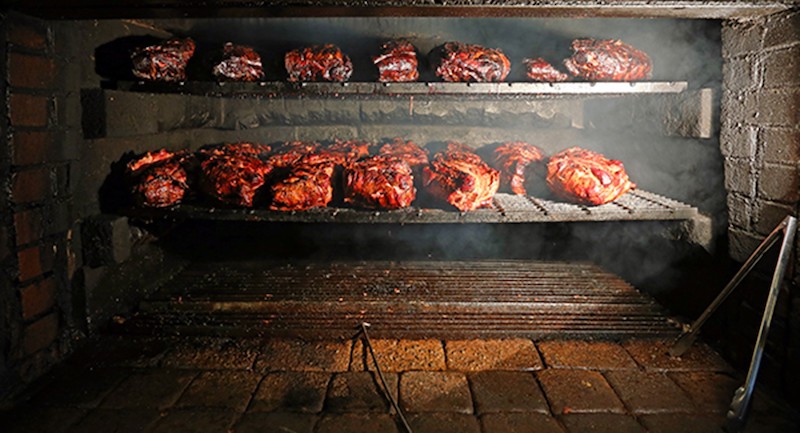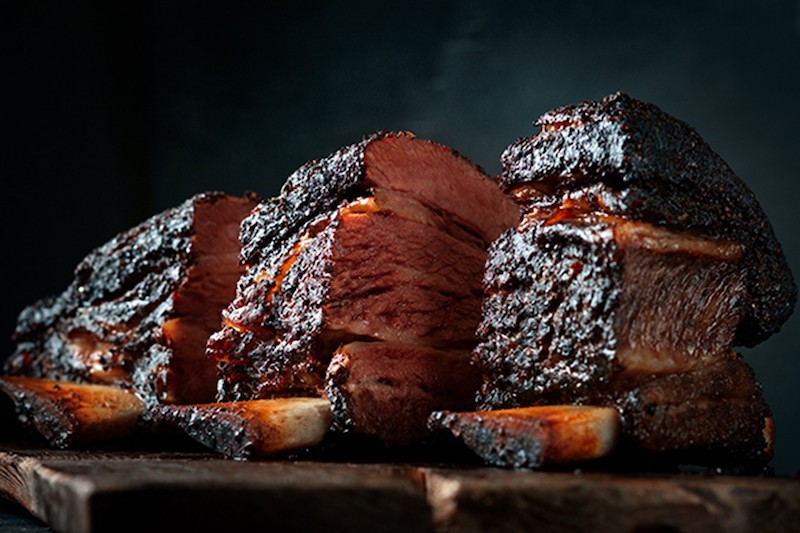It's Time to Barbecue!
Many use the terms barbecue and grill interchangeably - but the difference is vast, especially to those who take barbecue seriously.
May 13, 2022
In America, the precise definition of “barbecue," both the noun and the verb, is highly localized and contentious. I could spend this entire article running through regional variations. But I'll make a declaration summarizing the consensus right up front instead.
Grilling is quick, barbecue is slow.
So while a New Englander might discuss “barbecuing" fish, hot dogs and burgers on the grill, in parts of the country where people take barbecue seriously, locals would call that “grilling." In much of the American South, barbecue is by definition slow. The process requires many hours using low, indirect heat, usually from firewood.
So while grilling is common, quick and easy, barbecue takes considerably more time and effort. That's why barbecue restaurants are common. Professionals barbecue meats for long hours en masse, saving the rest of us the time and trouble.
The first barbecue
Slow-cooking over low heat made perfect sense for people with more time than food. It makes the toughest meat tender, so the cook wastes neither food nor fuel.
Taino-Arawak and Carib natives in Hispaniola dried and hot-smoked fish, alligator and deer on lattice frames. They burned green wood to keep the temperature low. They called the frame a babracot. The Spanish conquistadors called it barbacoa, which became barbecue.
The fact that barbecue uses indirect flame allows stacked racks of cooking meat. That means that although cooking times are long, the amount of fuel needed per portion is low. The time required surprised observers. As an early French traveler noted incredulously “A Caribbee has been known, on returning home from fishing fatigued and pressed with hunger, to have the patience to wait the roasting of a fish on a wooden grate fixed two feet above the ground, over a fire so small as sometimes to require the whole day to dress it."

Natives further north also practiced slow, indirect cooking. In 1540, in Mississippi, the Chickasaw tribe, in the presence of explorer Hernando de Soto, prepared a feast of pork over the barbacoa.
By 1690, the English knew the term so well that it appeared in Aphra Behn's play “The Widow Ranter," in which a rabble-rouser turns against Captain Dullman, shouting “Let's Barbicu this Fat Rogue!" However, it's not clear that the colonists barbecued; they may have considered it a barbaric custom for natives and slaves from the Caribbean. In 1769, when George Washington noted in his diary that he had attended a “Barbecue," he may have meant an outdoor social gathering where animals would be roasted whole over a fire, rather than slow-cooked with indirect heat.
Wild pigs fed the South
The Spanish brought pigs to the Americas and the creatures became a pestilence, overgrowing in the woods. Left to fend for themselves in the wild, the pigs of the old South were lean and tough. Southerners relied on slow-cooking to harvest every part of the pig and make a poor family's meat delicious. Adding sauce to the meat came from the British, who influenced Eastern North Carolina's classic vinegar-based sauce (think of the British pouring vinegar on chips). Some original recipes added the very local ingredient, oysters. Go west within the state, and you'll find tomato in your sauce, possibly an innovation from Bavarians who liked their pork shoulder sweet. In South Carolina, French and German immigrants opted for mustard bases (think of French Dijon and German mustard).
Brisket makes Eastern Europeans feel at home
Classic Texas barbecued brisket. Long, slow, indirect cooking for up to 15 hours tenderizes this tough, inexpensive cut of beef. The more you travel west, into cattle country, the more likely your barbecue is beef. Early on, it's likely that slaves brought the cooking method with them from the South. When Germans, Russians, Poles and Czechs arrived by rail in Texas, they brought their own traditions, notably sausage and brisket. In Lockhart, Texas, for example, the "smokemasters" have their Polish forebears in mind.

Kansas City, Missouri, land of stockyards, cooks it all. In the early 1900s, a man named Henry Perry set up a pushcart where he sold beef, ribs and raccoon wrapped in newspaper. He moved to the Vine Street Corridor, a Black neighborhood where barbecue became a competitive sport. A man named Arthur Bryant gets the credit for turning Kansas City sauce thick and super-sweet. That trick that now makes KC sauce the favorite on supermarket shelves.
Salmon Candy
Salmon candy, cooked slowly and indirectly over an alder wood fire, blurs the distinction between smoking and barbecuing – it's a bit of both. People have been smoking salmon and other fish, of course, for centuries. East Coast mavens know cold-smoked salmon, aka lox. Heat isn't involved. However, fish-smoking can become a kind of barbecuing when you add a small amount of very indirect heat to preserve the delicate flesh. The Tlingit Indians of the Pacific Northwest barbecued salmon for as long as six days for community potlaches or feasts, using smoke from alder wood, a native scrub tree.

Salmon candy is a Pacific Northwest treat. Vital Choice marinates fine sockeye or wild king salmon in a light salt brine mixed with organic brown sugar before smoking it in the traditional way over alder. Salmon candy is also sometimes glazed with maple syrup or honey. Either way, you have protein and omega-3s in a concentrated sweet, salty, satisfyingly chewy package. It's definitely a strategy to try when coaxing little ones to embrace salmon as their favorite. Or you could just put a sweet Kansas City barbecue sauce on a grilled salmon!
Barbecue conquers the world
By the 1950s, Americans made barbecue an “all-American" symbol. Like other American pastimes, it proved popular, spreading to the United Kingdom, Australia and Germany. It is, in fact, a classic American melting-pot phenomenon, mixing native wisdom with immigrant culture with delicious results. So fire up that small, slow, indirect-heating barbecue!







